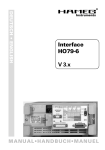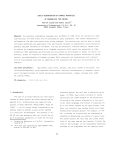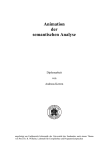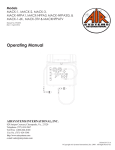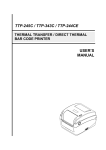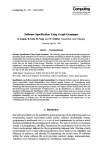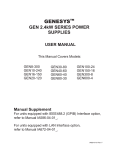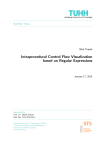Download Geschichte der Programmiersprachen - Friedrich
Transcript
(Anmerkungen zur)
Geschichte der Programmiersprachen
Prof. Dr. Hans J. Schneider
Department Informatik (Informatik 2)
Friedrich-Alexander-Universität Erlangen-Nürnberg
Wintersemester 2011/12
I. Die frühe Geschichte der Programmiersprachen
II. Grundsätzliche Untersuchungen
6. Formale Definition der Syntax
7. Ansätze zur Compilerentwicklung
8. Typsicherheit, Orthogonalität, Effizienz
9. (Automatisiserung der Compilerentwicklung)
III. Beherrschung großer Systeme
IV. Ergänzungen
c Hans J. Schneider 2011
Overview
• The first languages were defined by English prose.
– Advantage: Easy to read
– Disadvantage: Prone to ambiguities and misunderstanding
• First approach to formal syntax definition: Algol 60
– Backus developed a notation based on Chomsky’s contextfree grammars (that allow efficient parsing algorithms).
– Each definition consisted of three sections: Syntax - Examples - Semantics
• “Static semantics”:
– Syntactic properties that are not contextfree were described under
the heading “Semantics”.
– In the literature, this decision led to the misunderstandable notion of “static semantics”, since these “semantic” properties could be
checked at compile-time.
• Van Wijngaarden and his group extended the definition to include noncontextfree properties.
Geschichte der Programmiersprachen
6.1
Definition of Fortran: Expressions
By repeated use of the following rules, all permissible expressions may be
derived.1
1. Any fixed point (floating point) constant, variable, or subscripted variable is an expression of the same mode. Thus 3 and 1 are fixed point
expressions, and ALPHA and A(I,J,K) are floating point expressions.
2. . . .
3. If E is an expression, and if its first character is not + or -, then +E and
-E are expressions of the same mode as E. Thus -A is an expression, but
+-A is not.
4. If E is an expression, then (E) is an expression of the same mode as E.
Thus (A), ((A)), (((A))), etc. are expressions.
5. If E and F are expressions of the same mode, and if the first character
of F is not + or -, then E+F, E-F, E*F, and E/F are expressions of the
same mode. Thus A-+B and A/+B are not expressions.
1
Aus dem ersten FORTRAN Manual (1956), zitiert nach:
J.W. Backus: The history of Fortran I, II, and III, ACM SIGPLAN Not. 13, 8 (1978), pp. 165-180
Geschichte der Programmiersprachen
6.2
Definition of Fortran: Subscripts
• Subscripts
General form: Let v represent any fixed point variable and c (or c’) any
unsigned fixed point constant. Then a subscript is an expression of
one of the forms:
v
v+c c*v+c’
c
v-c c*v-c’
c*v
The symbol * denotes multiplication. The variable v must not itself
be subscripted.
• Subscripted variables
General form: A fixed or floating point variable followed by parentheses
enclosing 1, 2, or 3 subscripts separated by commas.
Examples:
A(I)
1
K(3)
BETA(5*J-2,K+2,L)
loc. cit.
Geschichte der Programmiersprachen
6.3
Chomsky-Grammatiken
• Noam Chomsky führt 1956 im Zusammenhang mit linguistischen Fragestellungen den Begriff der Phrase structure grammar“ ein.1
”
• 1959 formalisiert er diese auf der Basis der Semi-Thue-Systeme und definiert eine Hierarchie von Grammatiken und Sprachen.2
• A phrase structure grammar consists of a finite set of
”rewriting rules” of the form φ → ψ, where φ and ψ
are strings of symbols. It contains a special ”initial”
symbol S (standing for ”sentence”) and a boundary
symbol # indicating the beginning and end of sentences. Some of the symbols of the grammar stand for
words and morphemes (grammatically significant parts
of words). These constitute the ”terminal vocabulary.”
Other symbols stand for phrases, and constitute the
”nonterminal vocabulary” (S is one of these, standing
for the ”longest” phrase).
1
2
N. Chomsky
(*1928)
N. Chomsky: Three models for the description of language, IRE Transactions on Information Theory 2(1956), pp. 113-124
N. Chomsky: On certain formal properties of grammars, Information and Control 2 (1959), pp. 137-167
Geschichte der Programmiersprachen
6.4
Chomsky-Hierarchie
• Die Chomsky-Hierarchie schränkt schrittweise die Form der zulässigen
Ersetzungsregeln (Produktionen) ein:1
– Restriction 1: If ϕ → ψ, then there are A, ϕ1 , ϕ2 , ω such that ϕ = ϕ1 Aϕ2 ,
ψ = ϕ1 ωϕ2 , and ω 6= I.
– Restriction 2: If ϕ → ψ, then there are A, ϕ1 , ϕ2 , ω such that ϕ = ϕ1 Aϕ2 ,
ψ = ϕ1 ωϕ2 , ω 6= I, but A → ω.
– Restriction 3: If ϕ → ψ, then there are A, ϕ1 , ϕ2 , ω, a, B such that
ϕ = ϕ1 Aϕ2 , ψ = ϕ1 ωϕ2 , ω 6= I, A → ω, but ω = aB or ω = a.
• Die unbeschränkten Grammatiken entsprechen den Semi-Thue-Systemen; das Wortproblem ist unentscheidbar.
– Einschränkung 1 macht das Wortproblem entscheidbar, aber mit exponentiellem Aufwand.
– Einschränkung 2 (kontextfreie Grammatiken) erlaubt Algorithmen
mit polynomialem Zeitbedarf.
– Einschränkung 3 entspricht den regulären Ausdrücken (endlichen Automaten).
1
N. Chomsky: On certain formal properties of grammars, Information and Control 2 (1959), pp. 137-167
Geschichte der Programmiersprachen
6.5
Das Entstehen der BNF
• Ende 1958 erscheint eine erste Vorversion von Algol (International Algebraic Language).1
• Im November 1959 stellt J.W. Backus auf der ersten internationalen Konferenz über Information Processing“ in Paris ein Konzept zur formalen
”
Beschreibung der Sprache vor.2
• Backus:
– There must exist a precise description of those
sequences of symbols which constitute legal
IAL programs.
– For every legal program there must be a precise description of its ”meaning”, the process
or transformation which it describes, if any.
– Only the description of legal programs has been
completed however.
J.W. Backus
(1924-2007)
1
A.J. Perlis/K. Samelson: Preliminary Report – International Algebraic Language, Comm. Assoc. Comput. Mach. 1, 12
(1958), pp. 8-22
2
J.W. Backus: The syntax and semantics of the proposed international algebraic language of the Zurich ACM-Gamm
conference, Proc. Int. Conf. Information Processing, Oldenbourg, München, 1960, pp. 125-132
Geschichte der Programmiersprachen
6.6
Backus-Naur-Form: Konzept
• Die Backus-Naur-Form (anfangs auch Backus Normal Form1 ) entspricht
den kontextfreien Grammatiken. Die Produktionen werden durch metalinguistische Formeln codiert.
• Bausteine:2
– Sequences of characters enclosed in the brackets <> represent metalinguistic variables whose values are sequences of symbols.
– The marks ::= and | are metalinguistic connectives.
– Any mark in a formula, which is not a variable or a connective, denotes itself.
– Juxtaposition of marks and/or variables in a formula signifies juxtaposition of the sequences denoted.
• Bedeutung der expliziten Verknüpfungen:
– ::= bedeutet
– | bedeutet
1
2
”
is defined as“.
”
or“.
D.E. Knuth: Backus Normal Form vs. Backus Naur Form, Communicat. Assoc. Comp. Mach. 7, 12 (1964), pp. 735-736
P. Naur (Ed.): Report on nthe algorithmic language ALGOL 60, Numerische Mathematik 2 (1960), pp. 106-136
Geschichte der Programmiersprachen
6.7
Backus-Naur-Form: Beispiel
• Definition arithmetischer Ausdrücke:1
<arithmetic expression> ::= <term>
| <adding operator> <term>
| <arithmetic expression> <adding operator> <term>
<term> ::= <factor>
| <term> <multiplying operator> <factor>
<factor> ::= <primary>
<factor> ↑ <primary>
<primary> ::= <unsigned integer> | <variable>
| (<arithmetic expression>)
<multiplying operator> ::= × | / | ÷
<adding operator> ::= + | −
P. Naur
(*1928)
1
P. Naur (Ed.): Revised Report on the Algorithmic Language ALGOL 60, Communicat. Associat. Comput. Mach. 6, 1
(1963), pp.1-17; Numer. Math. 4 (1963), pp. 420-453
Geschichte der Programmiersprachen
6.8
Graphische Darstellungen
• Kontextfreie Grammatiken erlauben eine graphische Darstellung der
Satzstruktur (Programmstruktur) als Ableitungsbaum (”Parse tree‘“):
– Die Blätter sind mit terminalen Symbolen, die übrigen Knoten mit
nichtterminalen Symbolen markiert.
– Der Baum gibt die Struktur gemäß der Grammatik wieder, z.B. den
Operatorenvorrang.
– Unwesentlich verschiedene Ableitungen führen zum gleichen Baum.
– Gibt es zu einer Zeichenfolge zwei unterschiedliche Ableitungsbäume,
so ist die Grammatik mehrdeutig.
• Nicht alle nichtterminalen Symbole, die in einer Ableitung auftreten, sind
zum Verständnis der abgeleiteten Zeichenkette erforderlich. Der abstrakte Syntaxbaum konzentriert sich auf das Wesentliche.
• Anmerkung: Die Übersetzung zwischen beiden Darstellungen kann durch
Graphersetzungsregeln formal beschrieben werden.
Geschichte der Programmiersprachen
6.9
Beispiel zur graphischen Darstellung
ar.expr
HH
H
ar.expr
add.opt
H
HH
term
@
@
@
ar.expr add.opt term
term
−
+
@
@
@
term mulopt f actor
f actor
f actor
f actor
primary
primary
primary
var
uns.int
/
primary
var
+
−
var
Geschichte der Programmiersprachen
var
@
@
var
H
HH
H
int
/
@
@
var
6.10
Lexikalische Struktur
• The lexical structure of a programming language, i.e., the structure of its
words or tokens, can be considered separately from syntactic structure,
although in some cases, it is an inextractable part of syntax.1
• Typische Bausteinkategorien: Schlüsselwörter, Konstanten (Literale),
Sonderzeichen (Operatoren, Trennzeichen, usw.), Bezeichner ( Identi”
fier“)
• Probleme und Lösungen:
– Fortran: Keine Unterscheidung zwischen Schlüsselwörtern und Bezeichnern
– Algol 60: Schlüsselwörter fett gedruckt bzw. in Apostroph eingeschlossen
– Später: Schlüsselwörter sind reservierte Zeichenfolgen.
– Anfangs waren Bezeichner auf eine maximale Länge beschränkt, oder
nur die ersten sechs bzw. acht Zeichen dienten der Unterscheidung.
• Die saubere Trennung erlaubt die separate Konstruktion von Scanner“
”
und Parser“.
”
1
K.C. Louden: Programming Languages - Principles and Practice PWS-KENT Publ., Boston, 1993
Geschichte der Programmiersprachen
6.11
Lexikalische Struktur in Fortran und C
• Das ursprüngliche Fortran ist ein Beispiel, wo Scanner“ und Parser“
”
”
nicht getrennt werden können:
DO 99 I = 1.10
DO 99 I = 1,10
entsprechen den Pascal-Formulierungen:
DO99I := 1.10
for I := 1 to 10 do
• Die Definition in C zeigt das Problem auf:1
Blanks, horizontal and vertical tabs, newlines, formfeeds, and comments
(collectively, “white space”) . . . are ignored except as they separate tokens. Some white space is required to separate otherwise adjacent identifiers, keywords, and constants. If the input stream has been separated
into tokens up to a given character, the next token is the longest string
of characters that could constitute a token.
1
B.W. Kernighan/D.M. Ritchie: The C programming language (ANSI Standard C), Prentice-Hall, Englewood Cliffs, N.J.,
1988
Geschichte der Programmiersprachen
6.12
Cobol: Syntaxbeschreibung
• For some languages, such as Cobol and PL/I, much greater conciseness of
specification can be achieved by using a two-dimensional layout whereby
alternatives may be listed vertically within a large pair of braces. Square
brackets indicate optionality, and “. . . ” denotes arbitrary repetition of
the preceding unit.1
• Beispiele (COBOL-ADD, PL/I-Loop):
ADD
constant
variable
,
constant
variable
···
TO
GIVING
variable
TO expression [BY expression]
[while ( expression )]
expression
BY expression [TO expression]
• I think it is fair to say that the COBOL syntactic philosophy (e.g. few
verbs with many options per verb) simply could not have been carried
through, if we had used BNF from the beginning.2
1
F.G. Pagan: Formal Specification of Programming Languages – A Panorama Primer, Prentice-Hall, Englewood Cliffs,
N.J., 1981
2
J.E. Sammet: The early history of COBOL, ACM SIGPLAN Not. 13, 8 (1978), pp. 121-161
Geschichte der Programmiersprachen
6.13
Extended Backus-Naur Form
• Some drawbacks of the BNF:
– Recursive BNF rules are often used to define repetition of substructures.
– Alternatives are often used to define optional substructures.
• Defining Pascal, N. Wirth developed a variant of the
BNF, called Extended BNF (EBNF), to avoid these
drawbacks.1
• Changes for more convenient notation:
– Nonterminals no longer enclosed in < . . . >.
N. Wirth
(*1934)
– Terminals enclosed in “ . . . ”.
• Adopted as a standard by the International Organization for Standardization (ISO/IEE 14977).
1
K. Jensen/N. Wirth: Pascal – User Manual and Report, Springer, Berlin, 1974
Geschichte der Programmiersprachen
6.14
Extended Backus-Naur Form: Details
• Recursive BNF rules are often used to define repetition of substructures:
– <arithmetic expression> ::= <term>
| <arithmetic expression> <adding operator> <term>
– replaced by:
<arithmetic expression> ::=
<term> { <adding operator> <term> }∗
• Disadvantage: obscures left-associativity of operators.
• Alternatives are often used to define optional substructures:
– <if statement> ::= if <condition> then <statement>
| if <condition> then <statement> else <statement>
– replaced by:
<if statement> ::=
if <condition> then <statement> [ else <statement> ]
Geschichte der Programmiersprachen
6.15
W-Grammars
• A W-grammar consists of two finite sets of rules, the metaproductions
and the hyperrules. These combine to permit the formation of a potentially infinite set of productions, which are used to define the syntax and
the context-sensitive requirements.
• Metaproductions:
– Metaproductions are context-free productions.
– The nonterminals of metaproductions are called metanotions.
– Their terminal strings are called protonotions.
• Hyperrules:
– A hyperrule is a blueprint from which context-free productions can
be obtained by replacing each metanotion by a protonotion derived
from the metaproductions.
– In making this substitution, all occurrences of the same metanotion
in the hyperrule must be replaced by the same protonotion.
1
2
A. van Wijngaarden et al.: Report on the Algorithmic Language Algol 68, Numer. Math. 14 (1969), pp. 79-218
M. Marcotty et al.: A sampler of formal definitions, ACM Comput. Surveys 8, 2 (1976), pp. 191-276
Geschichte der Programmiersprachen
6.16
W-Grammars: Notations
• Metaproductions:
– The nonterminals of metaproductions, called metanotions, are written in uppercase letters.
– Their terminal strings, the so-called protonotions, consist of lower
case characters (with blanks added to improve readability).
– PLAIN :: int; real; bool; . . .
MODE :: PLAIN; ref MODE.
• Hyperrules:
– A hyperrule is a blueprint to create context-free productions.
– ref MODE assignation :
ref MODE destination, becomes symbol, MODE source.
• Lists of identifiers, lists of parameters, etc:
ALPHA :: a; b; c; . . . ; z.
NOTION :: ALPHA; NOTION ALPHA.
NOTION list : NOTION;
NOTION list, comma symbol, NOTION.
Geschichte der Programmiersprachen
6.17
W-Grammar Defining Expressions
• Hyperrules:
MODE PRIORITY formula:
LMODE PRIORITY operand,
LMODE and RMODE giving MODE PRIORITY operator,
RMODE PRIORITY plus one operand.
MODE PRIORITY operand:
MODE PRIORITY formula;
MODE PRIORITY plus one operand.
MODE expression:
MODE PRIORITY operand.
• Metaproductions:
LMODE
:: MODE.
RMODE
:: MODE.
PRIORITY :: priority NUMBER.
1
Report Sect. 8.4 (simplified)
Geschichte der Programmiersprachen
6.18
W-Grammar Defining Expressions (Cont’d)
• Metaproductions:
PRIORITY :: priority NUMBER.
NUMBER :: one; TWO; THREE; FOUR; FIVE;
SIX; SEVEN; EIGHT; NINE.
TWO
:: one plus one.
THREE
:: TWO plus one.
...
• Hyperrules:
MODE PRIORITY NINE plus one operand:
MODE primary.
MODE primary:
MODE constant;
ref MODE variable;
open symbol, MODE expression, close symbol.
Geschichte der Programmiersprachen
6.19
Generative Power of W-Grammars
• A finite set of attributes can be treated by increasing both the set of
nonterminal symbols and the set of productions.
– Construct new symbols that consist of a symbol together with special
values of the attributes.
– Copy the productions for each valid combination of the new symbols.
• Sintzoff could show that the generative power of W-grammars is the same
as that of unrestricted Chomsky grammars.1
• The word problem is undecidable.
• Koster proposed a restricted syntax.2
1
M. Sintzoff: Existence of a van Wijngaarden syntax for every recursively enumerable set, Annales Soc. Sci. Bruxelles II
(1967), pp. 115-118
2
C.H.A. Koster, Affix grammars, in: J.E.L. Peck (Ed.): Algol 68 implementation, North-Holland, Amsterdam, 1971,
pp. 95-109
Geschichte der Programmiersprachen
6.20
Extensible Languages
• Galler/Perlis proposed an extension to Algol 60 for adding new data
types and operators to the language.1
• Irons:2 New syntactic constructs can be introduced in a program by defining
– the syntax similar to an attributed version of BNF, and
– the semantics similar to a procedure body using the base language
including the extensions up to this one.
• Such an extension is similar to a procedure declaration, but it allows the
programmer to use a more appropriate syntax instead of the fixed syntax
of a procedure call, e.g.,
find X in LIST instead of find(X, LIST)
• Irons’s system treated the extensions similar to precompiled procedures
and implemented the extended syntax by bootstrapping.
1
B.A. Galler/A.J. Perlis: A proposal for definitions in ALGOL, Communicat. Associat. Comput. Mach. 10,4 (1967),
pp. 204-219
2
E.T. Irons: Experience with an extensible language, Communicat. Associat. Comput. Mach. 13, 1 (1970), pp. 31-40
Geschichte der Programmiersprachen
6.21
Example of an Extension
• Example (slightly modified): Right-hand assignment: e → v
<rhd-ass> :: <e, expression> --> <v, identifier> :: ’v := e’
– <rhd-ass>: Nonterminal symbol to be defined.
– <e, expression>: e must satisfy the definition of an expression.
– ’v := e’: The semantics is the same as that of the usual assignment.
• Many people felt that a programming language should be extensible such
that it may be used in another application area, but only very few implementations are known.
Geschichte der Programmiersprachen
6.22
Sammet: The Use of English as a Programming Language
• When I say that I wish to use English as a programming language, I very
definitely include mathematics or any other scientific notation.
• Reasons why to use English:
– There are too few programmers for the machine capacity we have.
Therefore, it is desirable to eliminate the need for professional programmers for handling applications.
– To put every person in communication with the computer is to speed
up and make easier his ability to get his problem solved. It was for
just such reasons that systems such as Fortran were developed. I
simply want to extend this concept to its furthest limits.
– Every application area has its own jargon, and the less a user has to
jump out of this the better off he is. Only by encompassing all jargon
areas – which would mean all of English – can we achieve this.
• Using English definitely involves the requirement for the computer to
query the user if there is any doubt.
1
J.E. Sammet: The use of English as a programming language, Communicat. Associat. Comput. Mach. 9 (1966), pp. 228-
230
Geschichte der Programmiersprachen
6.23
























